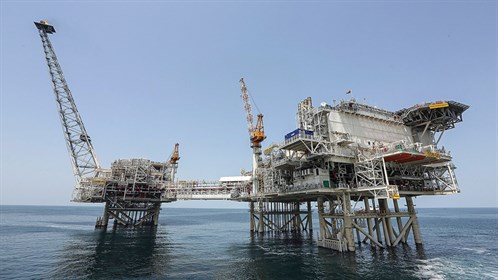Regional Focus: Mega-project in the FSU: Ongoing development of the Shah Deniz gas field
Multiple billions of dollars have been invested to develop the Shah Deniz gas field. The project is led by the government of Azerbaijan and Lukoil Corp. and requires the ongoing construction of enormous, expensive assets.
One reason for the high cost and complexity of the venture is that gas extracted from the Shah Deniz’s Stage 2 development is delivered from Azerbaijan to Europe via the Southern Gas Corridor (SGC). The $8.5-B, multinational SGC natural gas project is supported by the European Commission and financed by the World Bank, the European Bank for Reconstruction and Development (EBRD) and the Asian Infrastructure Investment Bank (AIIB).
Energy security from the Southern Gas Corridor. The SGC consists of three distinct sections, each located in parts of the world that are in conflict: the South Caucasus Pipeline (SCP), which flows from the Caspian Sea to the Georgia–Turkey border; the Trans-Anatolian Natural Gas Pipeline (TANGP), which flows from the Georgia–Turkey border to the Turkey–Greece border; and the Trans-Adriatic Pipeline (TAP), which flows from the Turkey–Greece border into Italy.
An additional reason for Shah Deniz’s complexity is the fact that it is a high-temperature, high-pressure gas field located 70 km offshore, to the southeast of the Azerbaijani capital of Baku. The field lies beneath water depths of 50 m–500 m, with a reservoir thickness of more than 1,000 m, stretching for 22 km. Shah Deniz contains nine vertically stacked reservoir units, which are targeted for depletion in two stages. The gas-initially-in-place estimate for the field is 938 Bm3. Stage 1 of the gas field has been operational since December 2006.
As a part of the Shah Deniz 2 project (also called the Shah Deniz Full Field Development), BP has been expanding the SCP—through a program of capacity extension—by installing two additional compressor stations in Georgia and Turkey. This nearly triples the transportation capacity of the SCP, enabling it to accommodate an additional 16 Bm3y coming from Shah Deniz Stage 2 (FIG. 1).
 |
| FIG. 1. Shah Deniz 2 platform topsides offshore Azerbaijan in the Caspian Sea. Photo courtesy of BP. |
The SCP is a geopolitically significant natural gas pipeline, due in part to Europe’s anxiety about the military and security threat posed by Russia. Deliveries from Shah Deniz run for 430 m/692 km on the 42-in. pipeline, which has a capacity of 25 16 Bm3y and is jointly operated by BP and Norway’s Equinor. The pipeline’s parent company is jointly owned by a consortium led by BP and the State Oil Company of Azerbaijan Republic (SOCAR).
The SCP’s main purpose is to supply natural gas to Turkey and Georgia. In the first eight months of 2020, Turkey’s gas imports from Azerbaijan via the TANAP increased by more than 25% on the year, according to Turkish news site Enerji Günlüğü. As a transit country, Georgia has the rights to take 5% of the annual gas flow through the pipeline in lieu of a tariff. Georgia can purchase an additional 0.5 Bm3y at a discounted price. In the longer term, the pipeline aims to supply Europe with Caspian natural gas.
Shah Deniz 2 development progress. In July 2018, the Shah Deniz consortium partners announced the launch of Shah Deniz 2, including its first commercial gas delivery to Turkey. BP operates this $28-B project, which is the first subsea development in the Caspian Sea and the largest subsea infrastructure operated by BP worldwide.
Shah Deniz 2 is important because, together with the SGC pipeline system, it delivers significant new energy supplies to Europe. This helps further diversify Europe’s sources of energy, thereby reducing dependence on Russia. By providing new supplies of natural gas, the development has become an essential element in the EU’s much-debated and expensive energy transition to zero carbon.
At its peak, Shah Deniz 2 is expected to produce 16 Bm3y incrementally on top of existing Shah Deniz production. Together with output from the first phase of development, total production from the Shah Deniz field will rise to 26 Bm3y of gas and to 120,000 bpd of condensate. Shah Deniz is the largest gas discovery made by BP. When it was discovered in 1999, the giant field was estimated to hold approximately 1 Tm3 of gas.
The offshore complex is substantial in size, consisting of two bridge-linked, fixed-jacket production platforms; 26 subsea wells drilled with two semi-submersible rigs; and 500 km of subsea pipelines flowing to shore. Additionally, an expansion of the onshore gas processing terminal will involve brownfield tie-ins to the existing Sangachal Terminal. GP
 |
GORDON FELLER has been writing about energy (particularly oil and gas) since his first magazine article was published in 1978, and he has been published in more than
50 industry magazines. He has undertaken numerous research and writing projects for large institutions, including the World Economic Forum, the World Bank, and
the governments of Germany, the UAE (Abu Dhabi), Japan and Canada.




Comments